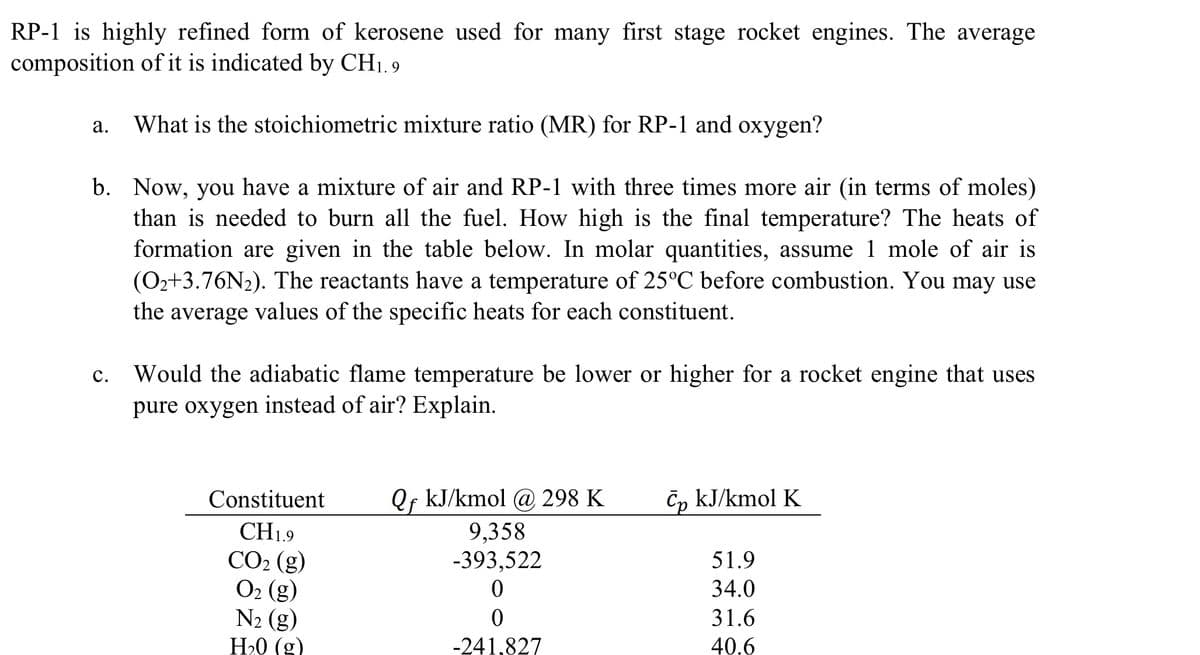RP-1 is highly refined form of kerosene used for many first stage rocket engines. The average composition of it is indicated by CH1.9 a. What is the stoichiometric mixture ratio (MR) for RP-1 and oxygen? b. Now, you have a mixture of air and RP-1 with three times more air (in terms of moles) than is needed to burn all the fuel. How high is the final temperature? The heats of formation are given in the table below. In molar quantities, assume 1 mole of air is (O2+3.76N2). The reactants have a temperature of 25°C before combustion. You may use the average values of the specific heats for each constituent. C. Would the adiabatic flame temperature be lower or higher for a rocket engine that uses pure oxygen instead of air? Explain. Constituent Qf kJ/kmol @ 298 K Cp kJ/kmol K CH19 9,358 CO2 (g) -393,522 51.9 O2 (g) 0 34.0 N2 (g) 0 31.6 H₂0 (g) -241.827 40.6
RP-1 is highly refined form of kerosene used for many first stage rocket engines. The average composition of it is indicated by CH1.9 a. What is the stoichiometric mixture ratio (MR) for RP-1 and oxygen? b. Now, you have a mixture of air and RP-1 with three times more air (in terms of moles) than is needed to burn all the fuel. How high is the final temperature? The heats of formation are given in the table below. In molar quantities, assume 1 mole of air is (O2+3.76N2). The reactants have a temperature of 25°C before combustion. You may use the average values of the specific heats for each constituent. C. Would the adiabatic flame temperature be lower or higher for a rocket engine that uses pure oxygen instead of air? Explain. Constituent Qf kJ/kmol @ 298 K Cp kJ/kmol K CH19 9,358 CO2 (g) -393,522 51.9 O2 (g) 0 34.0 N2 (g) 0 31.6 H₂0 (g) -241.827 40.6
Elements Of Electromagnetics
7th Edition
ISBN:9780190698614
Author:Sadiku, Matthew N. O.
Publisher:Sadiku, Matthew N. O.
ChapterMA: Math Assessment
Section: Chapter Questions
Problem 1.1MA
Related questions
Question

Transcribed Image Text:RP-1 is highly refined form of kerosene used for many first stage rocket engines. The average
composition of it is indicated by CH1.9
a.
What is the stoichiometric mixture ratio (MR) for RP-1 and oxygen?
b. Now, you have a mixture of air and RP-1 with three times more air (in terms of moles)
than is needed to burn all the fuel. How high is the final temperature? The heats of
formation are given in the table below. In molar quantities, assume 1 mole of air is
(O2+3.76N2). The reactants have a temperature of 25°C before combustion. You may use
the average values of the specific heats for each constituent.
C. Would the adiabatic flame temperature be lower or higher for a rocket engine that uses
pure oxygen instead of air? Explain.
Constituent
Qf kJ/kmol @ 298 K
Cp kJ/kmol K
CH19
9,358
CO2 (g)
-393,522
51.9
O2 (g)
0
34.0
N2 (g)
0
31.6
H₂0 (g)
-241.827
40.6
Expert Solution
This question has been solved!
Explore an expertly crafted, step-by-step solution for a thorough understanding of key concepts.
Step by step
Solved in 2 steps

Recommended textbooks for you

Elements Of Electromagnetics
Mechanical Engineering
ISBN:
9780190698614
Author:
Sadiku, Matthew N. O.
Publisher:
Oxford University Press

Mechanics of Materials (10th Edition)
Mechanical Engineering
ISBN:
9780134319650
Author:
Russell C. Hibbeler
Publisher:
PEARSON

Thermodynamics: An Engineering Approach
Mechanical Engineering
ISBN:
9781259822674
Author:
Yunus A. Cengel Dr., Michael A. Boles
Publisher:
McGraw-Hill Education

Elements Of Electromagnetics
Mechanical Engineering
ISBN:
9780190698614
Author:
Sadiku, Matthew N. O.
Publisher:
Oxford University Press

Mechanics of Materials (10th Edition)
Mechanical Engineering
ISBN:
9780134319650
Author:
Russell C. Hibbeler
Publisher:
PEARSON

Thermodynamics: An Engineering Approach
Mechanical Engineering
ISBN:
9781259822674
Author:
Yunus A. Cengel Dr., Michael A. Boles
Publisher:
McGraw-Hill Education

Control Systems Engineering
Mechanical Engineering
ISBN:
9781118170519
Author:
Norman S. Nise
Publisher:
WILEY

Mechanics of Materials (MindTap Course List)
Mechanical Engineering
ISBN:
9781337093347
Author:
Barry J. Goodno, James M. Gere
Publisher:
Cengage Learning

Engineering Mechanics: Statics
Mechanical Engineering
ISBN:
9781118807330
Author:
James L. Meriam, L. G. Kraige, J. N. Bolton
Publisher:
WILEY